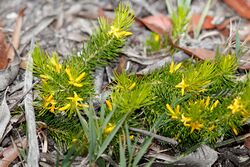Biology:Persoonia tenuifolia
| Fine-leaf geebung | |
|---|---|

| |
| Persoonia tenuifolia in Bald Rock National Park | |
| Scientific classification | |
| Kingdom: | Plantae |
| Clade: | Tracheophytes |
| Clade: | Angiosperms |
| Clade: | Eudicots |
| Order: | Proteales |
| Family: | Proteaceae |
| Genus: | Persoonia |
| Species: | P. tenuifolia
|
| Binomial name | |
| Persoonia tenuifolia | |
| Synonyms[1] | |
| |
Persoonia tenuifolia, commonly known as fine-leaf geebung[2] is a plant in the family Proteaceae and is endemic to eastern Australia. It is an erect to low-lying shrub with hairy young branchlets, linear leaves, and yellow flowers in groups of up to eight on a rachis 2–30 mm (0.079–1.181 in) long that continues to grow after flowering.
Description
Persoonia tenuifolia is a spreading to low-lying shrub that typically grows to a height of 20–50 cm (7.9–19.7 in) with its young branchlets covered with greyish hairs. The leaves are linear, 10–25 mm (0.39–0.98 in) long, 0.3–0.5 mm (0.012–0.020 in) wide and that usually curve upwards, with a groove on the lower surface. The flowers are arranged in groups of up to eight along a rachis 2–30 mm (0.079–1.181 in) long that usually continues to grow after flowering, each flower on a hairy pedicel 1–3 mm (0.039–0.118 in) long with a leaf at its base. The tepals are yellow and 8–10 mm (0.31–0.39 in) long and glabrous. Flowering mainly occurs from November to February.[2][3][4]
Taxonomy
Persoonia tenuifolia was first formally described in 1830 by Robert Brown in the Supplementum to his Prodromus Florae Novae Hollandiae et Insulae Van Diemen from specimens collected in 1827 near Moreton Bay by Charles Fraser.[5][6]
Distribution and habitat
Fine-leaf geebung grows in heath and forest from sea level to an altitude of 1,050 m (3,440 ft). It is found in near-coastal areas between Bundaberg in Queensland and Grafton in New South Wales and well as on the Great Dividing Range and nearby tablelands from Dalveen in Queensland to the Torrington and Yetman districts in New South Wales.[4]
References
- ↑ 1.0 1.1 "Persoonia tenuifolia". Australian Plant Census. https://biodiversity.org.au/nsl/services/apc-format/display/115530.
- ↑ 2.0 2.1 Weston, Peter H.. "Persoonia tenuifolia". Royal Botanic Garden Sydney. https://plantnet.rbgsyd.nsw.gov.au/cgi-bin/NSWfl.pl?page=nswfl&lvl=sp&name=Persoonia~tenuifolia.
- ↑ "Persoonia tenuifolia R.Br.". Flora of Australia Online. Department of the Environment and Heritage, Australian Government. http://www.anbg.gov.au/abrs/online-resources/flora/stddisplay.xsql?pnid=44600.
- ↑ 4.0 4.1 Weston, Peter H.. "Persoonia tenuifolia". Australian Biological Resources Study, Department of Agriculture, Water and the Environment: Canberra. https://profiles.ala.org.au/opus/foa/profile/Persoonia%20tenuifolia.
- ↑ "Persoonia tenuifolia". APNI. https://id.biodiversity.org.au/instance/apni/550114.
- ↑ Brown, Robert (1830). Supplementum primum prodromi florae Novae Hollandiae. London. p. 12. https://www.biodiversitylibrary.org/item/77294#page/526/mode/1up. Retrieved 11 November 2020.
Wikidata ☰ Q18075180 entry
 |

